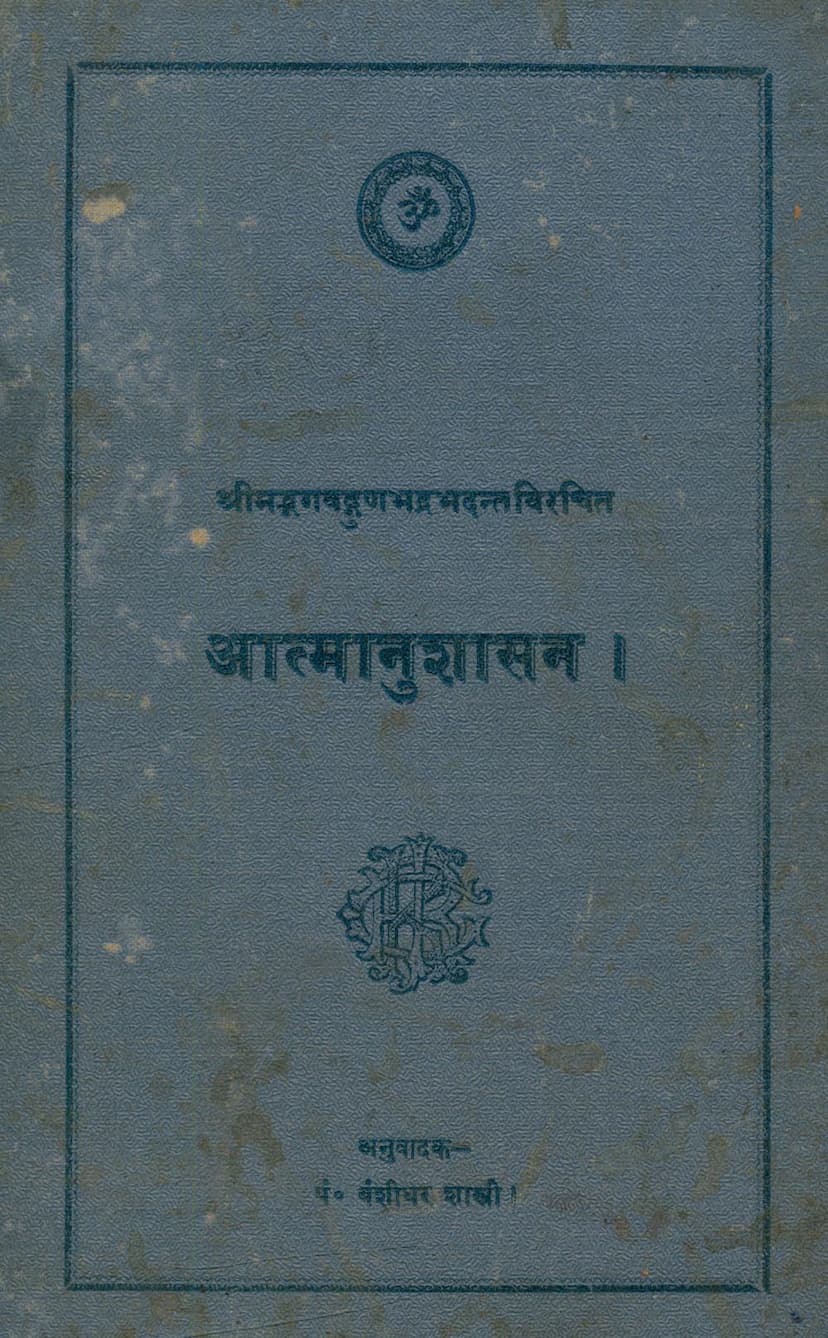Aatmanushasan
Added to library: September 1, 2025

Summary
Here's a comprehensive summary of the Jain text "Aatmanushasan" by Bansidhar Shastri, based on the provided pages:
Title: Aatmanushasan (Self-Discipline) Author: Acharya Nemichandra (Bhagvadgunbhadra) - The provided pages mention Acharya Nemichandra as the author of the original Sanskrit text, with Pandit Bansidhar Shastri as the Hindi translator and commentator. Publisher: Jain Granth Ratnakar Karyalay, Mumbai Translator/Commentator: Pandit Bansidhar Shastri Theme: A spiritual and ethical guide focusing on self-discipline, the path to liberation (moksha), and the essential principles of Jainism.
Overview:
"Aatmanushasan" is presented as a profound spiritual treatise within the Jain tradition. It aims to guide individuals towards self-improvement and ultimate liberation from the cycle of birth and death. The text emphasizes the importance of understanding the true nature of the self, controlling desires, practicing virtue, and adhering to the path prescribed by the Jain Tirthankaras. The Hindi translation and commentary by Pandit Bansidhar Shastri are intended to make this complex spiritual knowledge accessible to a wider audience.
Key Aspects and Themes:
-
Spiritual Guidance: The core purpose of the book is to provide guidance for spiritual upliftment. It delves into the "Aatman" (self) and its journey through the material world, highlighting the omnipresent suffering in the cycle of existence.
-
Importance of Spiritual Knowledge (Aadhyatmavidya): The text strongly advocates for the study and practice of spiritual knowledge, stating that true and lasting happiness can only be found by understanding and embracing spiritual principles. It suggests that this knowledge helps diminish worldly desires, leading to genuine peace.
-
The Author's (Acharya Nemichandra/Bhagvadgunbhadra) Significance: The author is highly esteemed in the Jain tradition. The commentary notes that Acharya Nemichandra's poetic and philosophical prowess is comparable to or even surpasses that of renowned Sanskrit poets. The text is described as containing not only general moral advice but also deep Jain philosophical secrets and a step-by-step path to liberation.
-
The Necessity of the Text: The preface emphasizes the universal need for spiritual knowledge, especially in a world filled with suffering. It argues that spiritual understanding is the key to navigating this suffering and achieving true happiness, which is unattainable through material pursuits alone.
-
Accessibility and Commentary: Pandit Bansidhar Shastri's Hindi commentary aims to explain the intricate Sanskrit verses in a clear and comprehensible manner. He acknowledges the value of previous commentaries, particularly that of Pandit Todarmalji, but explains his motivation for a new translation is to use contemporary Hindi, making the teachings accessible to the common person and further clarifying complex points.
-
The Fourfold Path (Aaradhana): The text seems to be structured around a fourfold path or "Aaradhana," which likely includes:
- Sammyagdarshan (Right Faith/Belief): The foundation of spiritual progress, involving correct understanding of Jain principles and deities.
- Gyan (Right Knowledge): The intellectual understanding of reality and the self.
- Charitra (Right Conduct/Action): The practice of virtues, vows, and ethical principles.
- Tapas (Austerities/Penance): Self-discipline and practices aimed at purifying the soul and burning away karma. The commentary meticulously breaks down the content, indicating a detailed exposition of each of these.
-
Critique of Worldly Attachments: A significant portion of the text (as evident from the detailed "Vishay Soochi" or Table of Contents) focuses on the transient nature and inherent suffering associated with worldly pleasures, possessions, body, family, wealth, and sensory enjoyments. It repeatedly criticizes attachment to these fleeting things, urging detachment.
-
The Nature of Suffering: The text analyzes the sources of suffering, attributing them primarily to ignorance, desire, attachment (moha), and the resultant karma. It highlights that true happiness (sukha) is found in detachment and self-realization, not in external possessions or sensory gratification.
-
The Role of Austerity (Tapas): Austerities are presented not as mere punishment but as a crucial means to purify the soul, overcome karma, and attain spiritual insight. The text discusses various forms and the importance of practicing them diligently.
-
Discrimination and Wisdom: The importance of distinguishing between the eternal self (soul) and the non-self (body, senses, mind, and external objects) is repeatedly stressed. True wisdom lies in recognizing the self's intrinsic nature and separating it from worldly illusions.
-
The Dangers of Complacency and False Interpretations: The commentary by Pandit Shastri points out errors or misinterpretations in earlier works, emphasizing the need for accurate understanding and adherence to the true principles of Jainism, especially regarding concepts like karma and liberation.
-
Praise for Asceticism and Detachment: The text extols the virtues of renunciation, detachment, and the practice of the monastic path, contrasting it with the suffering and futility of worldly pursuits. It idealizes the life of ascetics (munis) and their unwavering commitment to spiritual goals.
-
Ethical Principles: Underlying the spiritual discourse are fundamental Jain ethical principles such as non-violence (ahimsa), truthfulness (satya), non-stealing (asteya), celibacy (brahmacharya), and non-possessiveness (aparigraha), which are presented as crucial for both worldly well-being and spiritual progress.
-
The Impermanence of Life and the Body: The text repeatedly emphasizes the ephemeral nature of life, youth, health, and the body itself, urging readers to detach from them and focus on the eternal soul.
-
The Goal of Liberation (Moksha): The ultimate aim of all practices and spiritual understanding described is liberation from the cycle of reincarnation and suffering, achieving a state of eternal bliss and pure consciousness.
Overall Message:
"Aatmanushasan" serves as a comprehensive guide for spiritual seekers, offering profound insights into the Jain philosophy of karma, the nature of the soul, and the practical steps to achieve liberation. It calls for introspection, self-discipline, detachment from worldly allurements, and the cultivation of virtues, ultimately leading to the realization of the soul's true, blissful, and eternal nature. Pandit Bansidhar Shastri's commentary ensures this timeless wisdom remains accessible and relevant to modern readers.